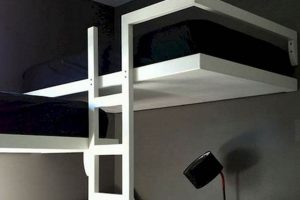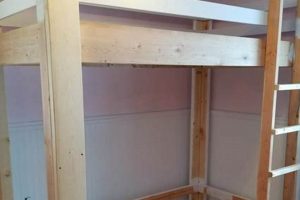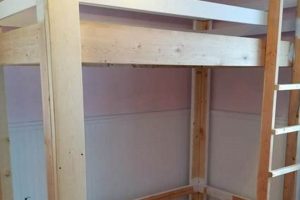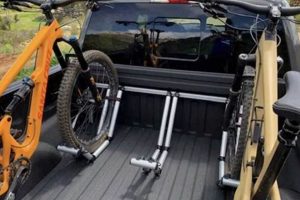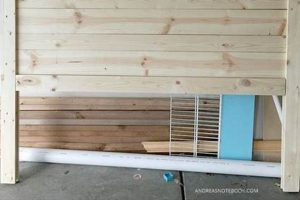A do-it-yourself bed extension platform provides accessible storage solutions in truck beds. These platforms, built by individuals rather than purchased pre-made, typically consist of a sliding base constructed from wood or metal and utilize rollers or drawer slides for smooth operation. This design allows for easy access to items stored at the front of the truck bed, eliminating the need to climb into the bed or reach over the side. For example, a contractor might construct one to organize tools and materials, improving efficiency on job sites.
The significance of creating a custom bed platform lies in its adaptability and cost-effectiveness. Such construction offers a tailored solution to meet specific needs, accommodating varying truck bed dimensions and storage requirements. This approach can be significantly less expensive than purchasing a commercially available unit, allowing for resource allocation to other areas. Historically, individuals have modified vehicles to enhance utility, and this is a continuation of that trend, reflecting a desire for personalized functionality.
Subsequent sections will detail the materials, tools, and construction steps involved in fabricating a bed platform. Furthermore, design considerations, safety precautions, and alternative construction methods will be explored. These elements will provide a comprehensive understanding of the planning and execution involved in this project.
Construction Considerations
The following guidelines aim to facilitate the effective and safe construction of a truck bed extension platform. These recommendations address material selection, design implementation, and operational safety.
Tip 1: Material Selection: Prioritize weather-resistant materials, such as pressure-treated lumber or marine-grade plywood, for the platform’s frame and surface. This choice will mitigate the effects of moisture and prevent premature degradation, extending the lifespan of the structure.
Tip 2: Slide Mechanism Evaluation: Consider heavy-duty drawer slides or rollers rated to support the anticipated load. Calculate the total weight of stored items and select a mechanism with a suitable safety factor to ensure smooth and reliable operation.
Tip 3: Secure Fastening: Employ robust fasteners, such as bolts, locking nuts, and construction screws, to assemble the frame and secure the sliding mechanism. Proper fastening is crucial for structural integrity and prevents component separation under stress.
Tip 4: Precise Measurement and Cutting: Ensure accurate measurements and precise cuts for all components. Inaccurate dimensions can lead to misalignment, binding, and reduced functionality of the sliding platform. Utilize accurate measuring tools and cutting equipment for optimal results.
Tip 5: Safety Lock Implementation: Incorporate a locking mechanism to secure the platform in both the extended and retracted positions. This prevents unintended movement during transit or loading/unloading, enhancing safety and preventing potential damage.
Tip 6: Surface Treatment: Apply a durable coating, such as paint or bed liner material, to protect the platform surface from abrasion and corrosion. This will enhance the platform’s appearance and extend its service life.
Tip 7: Accessibility Considerations: Design the platform with consideration for ease of access to stored items. Implement dividers, compartments, or tie-down points to organize cargo and prevent shifting during transit.
Adherence to these guidelines will contribute to the construction of a durable, functional, and safe bed extension platform. Careful planning and meticulous execution are essential for achieving optimal results.
The subsequent section will address potential design variations and customization options.
1. Structural Frame Rigidity
Structural frame rigidity is paramount in the context of a do-it-yourself bed extension platform. It directly influences the platform’s ability to support weight, withstand operational stresses, and maintain dimensional stability over its lifespan. Insufficient rigidity can lead to deformation, functional impairment, and potential safety hazards.
- Material Selection for Load Bearing
The choice of materials for the frame directly dictates its rigidity. High-density wood, steel, or aluminum are common selections, each possessing varying degrees of strength and resistance to bending. A frame constructed from low-grade plywood, for instance, is likely to exhibit significant flexure under load, compromising the platform’s intended functionality. Selecting appropriate materials for the intended load capacity is a critical design decision.
- Joint Integrity and Load Transfer
The methods used to join frame members significantly affect overall rigidity. Weak joints, such as those held together with inadequate fasteners or insufficient adhesive, can become points of failure under stress. Robust joints that effectively transfer load across the frame are essential. Welding, bolting with reinforcing plates, or the use of high-strength adhesives are common techniques employed to ensure joint integrity. The effectiveness of these methods dictates the overall frame strength.
- Cross-Bracing and Reinforcement
The addition of cross-bracing or reinforcement elements can significantly enhance the rigidity of the frame. Diagonal braces, gussets, or internal supports distribute load across a wider area, reducing stress concentrations and minimizing deformation. These elements are particularly important in platforms designed to carry heavy or unevenly distributed loads. A strategically placed brace can dramatically improve the platforms overall stability.
- Frame Geometry and Design Optimization
The geometric configuration of the frame also plays a crucial role in its rigidity. Rectangular frames, for example, are inherently less rigid than triangular or truss-style frames. Optimizing the frame’s design to distribute loads efficiently and minimize bending moments can significantly improve its structural performance. Finite element analysis (FEA) can be used to model the frame’s behavior under load, allowing for design refinements that maximize rigidity while minimizing material usage. This optimization can improve strength while reducing weight and cost.
The foregoing facets of structural frame rigidity underscore its critical role in the successful implementation of a do-it-yourself bed extension platform. Compromises in material selection, joint integrity, reinforcement strategies, or design optimization can all lead to diminished performance and potential failure. Prioritizing these considerations during the design and construction process is paramount for ensuring a durable, functional, and safe cargo management solution.
2. Sliding Mechanism Durability
The longevity and operational reliability of a do-it-yourself bed extension platform are directly contingent upon the durability of its sliding mechanism. The mechanism, responsible for facilitating the extension and retraction of the platform, experiences repeated stress and friction during use. Premature failure of this component renders the entire platform unusable. Consequently, the selection and installation of a robust and appropriate sliding mechanism are critical to the overall success of the project. Examples of failure include bearing collapse under sustained heavy loads, slide rail warping due to inadequate material strength, or locking mechanism malfunction resulting in unintended platform movement during transit.
The durability of the sliding mechanism is influenced by several key factors. Material composition, load-bearing capacity, and environmental resistance are primary considerations. Steel or high-strength alloy slides offer superior durability compared to plastic or low-grade metal alternatives. Furthermore, the mechanism’s design, including the type of bearings employed and the quality of the locking system, significantly impacts its operational lifespan. Practical applications demand mechanisms that can withstand frequent use, varying temperature conditions, and exposure to dirt and moisture within the truck bed environment. Regular maintenance, such as lubrication and cleaning, can further extend the lifespan of the sliding mechanism.
In summary, the sliding mechanism represents a critical point of potential failure within a do-it-yourself bed extension platform. Selecting a mechanism engineered for durability, considering factors such as material quality, load capacity, and environmental resistance, is essential for ensuring the platform’s long-term functionality. Furthermore, implementing a maintenance routine contributes significantly to extending the mechanism’s operational lifespan. A robust sliding mechanism translates to a reliable and cost-effective cargo management solution.
3. Weight Distribution Capacity
Weight distribution capacity is a critical factor in the design and construction of a do-it-yourself bed extension platform. It directly influences the platform’s structural integrity, operational safety, and longevity. Ensuring adequate weight distribution is not merely a matter of load-bearing; it encompasses the even dispersal of mass across the platform’s surface and the transfer of that load to the supporting vehicle structure.
- Platform Load-Bearing Surface Area
The size of the platform’s surface area significantly affects its ability to distribute weight. A larger surface area allows for the dispersal of the load over a wider region, reducing stress concentration on any single point. Insufficient surface area, conversely, can lead to localized overloading and potential structural failure. For instance, a narrow platform loaded with heavy objects may exhibit excessive bending or even collapse. This consideration dictates minimum dimensions based on anticipated cargo profiles.
- Frame and Support Structure Load Paths
The frame and support structure must be designed to effectively channel weight from the platform surface to the underlying truck bed. Load paths must be clear, direct, and optimized to minimize stress on individual components. Weak or poorly designed support structures can create stress concentrations, leading to fatigue and potential failure. Consider a frame where vertical supports are placed too far apart; the area between those supports may bow under load, undermining the entire platform’s integrity. Careful engineering is vital to ensure efficient weight transfer.
- Sliding Mechanism Load Rating Compliance
The selected sliding mechanism must possess a load rating that exceeds the maximum anticipated weight to be placed on the platform. Exceeding the mechanism’s load rating can result in premature wear, binding, or catastrophic failure. For example, using drawer slides rated for 100 pounds to support a 300-pound load will quickly degrade the slides and potentially lead to a complete breakdown. Proper selection of slides rated for the maximum load, with a safety margin, is essential.
- Vehicle Payload Capacity Adherence
The weight of the platform, combined with the weight of the cargo it carries, must remain within the vehicle’s specified payload capacity. Exceeding the vehicle’s payload capacity can compromise handling, braking performance, and overall safety. It can also lead to damage to the vehicle’s suspension and other components. Prior to constructing the platform, the vehicle’s payload capacity should be determined, and the design should be optimized to minimize weight without sacrificing structural integrity. Staying within the vehicle’s limits is not optional; it’s a mandatory safety consideration.
These facets underscore the importance of meticulously considering weight distribution capacity during the design and construction of a do-it-yourself bed extension platform. Neglecting these considerations can lead to structural failure, compromised safety, and reduced platform lifespan. A well-engineered platform will efficiently distribute weight, ensuring both the platform’s and the vehicle’s continued safe and reliable operation.
4. Material Weather Resistance
The inherent design of a do-it-yourself bed extension platform exposes its constituent materials to a range of environmental conditions, including precipitation, temperature fluctuations, and ultraviolet radiation. Material weather resistance, therefore, emerges as a critical determinant of the platforms longevity and functional integrity. Inadequate resistance to these elements precipitates degradation, compromising structural integrity and rendering the platform ineffective. For example, untreated wood, frequently utilized in such projects due to its availability and affordability, is highly susceptible to moisture absorption, leading to warping, rot, and ultimately, structural failure. Similarly, unprotected metal components corrode when exposed to prolonged moisture, weakening joints and reducing the platform’s load-bearing capacity. Selection of appropriate materials with inherent or enhanced weather resistance is thus fundamental to the successful construction of a durable bed platform.
The practical implications of neglecting material weather resistance are significant. A platform constructed from non-weather-resistant materials necessitates frequent maintenance and repairs, increasing the overall cost of ownership. Moreover, premature failure of the platform can lead to damage to the cargo it is intended to carry. In environments characterized by harsh weather conditions, such as regions with high humidity or frequent precipitation, the selection of weather-resistant materials becomes even more crucial. Pressure-treated lumber, marine-grade plywood, and powder-coated metal represent viable alternatives that offer enhanced protection against environmental degradation. Application of protective coatings, such as sealants and paints formulated for exterior use, can further augment material weather resistance, extending the platform’s service life.
In conclusion, material weather resistance is an indispensable consideration in the design and fabrication of a do-it-yourself bed extension platform. Failure to account for the impact of environmental factors on material integrity leads to compromised structural performance, increased maintenance requirements, and reduced platform lifespan. The judicious selection of weather-resistant materials, coupled with the application of appropriate protective coatings, represents a fundamental prerequisite for achieving a durable, reliable, and cost-effective cargo management solution within the demanding environment of a truck bed.
5. Cargo Accessibility Design
Cargo accessibility design is intrinsically linked to the functionality and user satisfaction of a do-it-yourself bed extension platform. The fundamental purpose of such a platform is to simplify access to items stored within the truck bed, particularly those positioned near the cab. Poor accessibility negates the benefits of the sliding mechanism, requiring users to climb into the bed or awkwardly reach over the sides, actions the platform is intended to eliminate. In effect, the design directly influences the efficiency with which users can load, unload, and retrieve cargo. An illustrative example is a contractor who installs a bed platform with insufficient consideration for reaching small tools. The result is that the contractor still has to climb onto the truck bed to reach the tools, thus negating the platforms intended advantage.
Effective cargo accessibility encompasses several design considerations. The platforms extension range must be sufficient to bring items within easy reach from the tailgate. Internal organization, such as dividers, drawers, or tie-down points, prevents cargo from shifting during transit and ensures that items remain readily accessible. The height of the platform relative to the truck bed sides also impacts ease of access, necessitating a balance between maximizing storage space and minimizing the effort required to lift items onto and off the platform. For instance, a platform with a low profile facilitates loading and unloading heavy items, while a higher platform maximizes storage capacity beneath the platform itself. This represents a tradeoff that must be strategically addressed based on individual needs.
Ultimately, cargo accessibility design is not merely an aesthetic consideration; it is a core functional attribute of any bed extension platform. Optimizing this aspect of the design requires a thorough understanding of the user’s needs, the types of cargo to be transported, and the physical limitations of the vehicle. Overlooking this integral design element renders the “do-it-yourself bed slide” less functional, thus reducing its practical value.
Frequently Asked Questions Regarding DIY Bed Platforms
The following section addresses common inquiries and clarifies misconceptions surrounding the construction and implementation of self-built truck bed extension platforms. The aim is to provide concise and informative answers to pertinent questions.
Question 1: Is specialized expertise required to construct a functional bed platform?
Proficiency in basic woodworking or metalworking techniques is recommended. Familiarity with power tools, accurate measurement, and structural assembly is advantageous. While not strictly mandatory, experience in similar projects mitigates potential errors and enhances the likelihood of a successful outcome.
Question 2: What are the most common design flaws observed in DIY bed platforms?
Insufficient structural support, inadequate weight distribution, and the use of inappropriate sliding mechanisms are frequently encountered. Failure to account for environmental factors, such as moisture and temperature fluctuations, also contributes to premature degradation.
Question 3: Are there legal restrictions or regulations governing the installation of a bed platform?
Local regulations pertaining to vehicle modifications may apply. Ensuring that the platform does not obstruct visibility, interfere with safety equipment, or exceed vehicle weight limits is imperative. Consult with local authorities to ascertain compliance requirements.
Question 4: What safety precautions should be observed during construction and operation?
Eye protection, hearing protection, and appropriate work gloves are essential during the construction process. Securely fasten all components, and thoroughly inspect the platform before each use. Avoid exceeding the platform’s weight capacity or placing unbalanced loads.
Question 5: What are the estimated costs associated with building a bed platform?
Material costs vary depending on the size, design, and materials selected. A basic platform can be constructed for a few hundred dollars, while more elaborate designs incorporating premium materials and features may exceed several thousand dollars. Labor costs are eliminated in DIY projects but should be factored into the overall value assessment.
Question 6: How can the platform’s design be customized to accommodate specific needs?
Design customization options include incorporating drawers, dividers, tie-down points, and adjustable shelving. The dimensions, materials, and sliding mechanism can be tailored to suit individual cargo requirements and vehicle specifications. Comprehensive planning is crucial for effective customization.
The key takeaway is that a successful build hinges on careful planning, adherence to safety protocols, and a thorough understanding of material properties and structural principles.
The subsequent section will explore advanced design concepts and integration strategies.
DIY Bed Slide
This exposition has thoroughly examined the multifaceted aspects of the DIY bed slide, spanning from fundamental construction considerations to nuanced design choices. The significance of structural integrity, sliding mechanism durability, weight distribution, material weather resistance, and cargo accessibility has been underscored. Failure to adequately address these critical elements compromises the efficacy and longevity of the resulting platform.
The construction of a bed platform represents a tangible investment in cargo management efficiency. A well-executed project provides a substantial return in terms of convenience, organization, and accessibility. Prospective builders are encouraged to meticulously evaluate their needs, diligently plan their design, and rigorously execute their construction. Diligence in these areas ensures the realization of a valuable asset.


